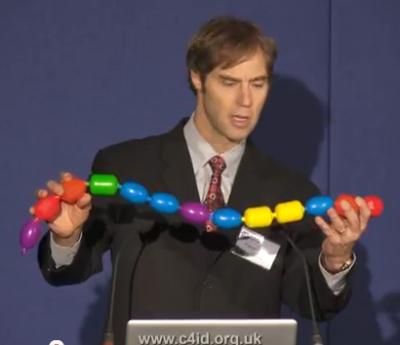A MUST-SEE lecture based on Dr. Stephen C. Meyer’s book “Signature in the Cell“.
You can get an MP3 of the lecture here. (30 MB)
I highly recommend watching the lecture, and looking at the slides. The quality of the video and the content is first class. There is some Q&A (9 minutes) at the end of the lecture.
Topics:
- intelligent design is concerned with measuring the information-creating capabilities of natural forces like mutation and selection
- Darwinists think that random mutations and natural selection can explain the origin and diversification of living systems
- Darwinian mechanisms are capable of explaining small-scale adaptive changes within types of organisms
- but there is skepticism, even among naturalists, that Darwinian mechanisms can explain the origin of animal designs
- even if you concede that Darwinism can account for all of the basic animal body plans, there is still the problem of life’s origin
- can Darwinian mechanisms explain the origin of the first life? Is there a good naturalistic hypothesis to explain it?
- there are at least two places in the history of life where new information is needed: origin of life, and Cambrian explosion
- overview of the structure of DNA and protein synthesis (he has helpful pictures and he uses the snap lock blocks, too)
- the DNA molecule is composed of a sequence of proteins, and the sequence is carefully selected to have biological function
- meaningful sequences of things like computer code, English sentences, etc. require an adequate cause
- it is very hard to arrive at a meaningful sequence of a non-trivial length by randomly picking symbols/letters
- although any random sequence of letters is improbable, the vast majority of sequences are gibberish/non-compiling code
- similarly, most random sequences of amino acids are lab-proven (Doug Axe’s work) to be non-functional gibberish
- the research showing this was conducted at Cambridge University and published in the Journal of Molecular Biology
- so, random mutation cannot explain the origin of the first living cell
- however, even natural selection coupled with random mutation cannot explain the first living cell
- there must already be replication in order for mutation and selection to work, so they can’t explain the first replicator
- but the origin of life is the origin of the first replicator – there is no replication prior to the first replicator
- the information in the first replicator cannot be explained by law, such as by chemical bonding affinities
- the amino acids are attached like magnetic letters on a refrigerator
- the magnetic force sticks the letters ON the fridge, but they don’t determine the specific sequence of the letters
- if laws did determine the sequence of letters, then the sequences would be repetitive
- the three materialist explanations – chance alone, chance and law, law alone – are not adequate to explain the effect
- the best explanation is that an intelligent cause is responsible for the biological explanation in the first replicator
- we know that intelligent causes can produce functional sequences of information, e.g. – English, Java code
- the structure and design of DNA matches up nicely with the design patterns used by software engineers (like WK!)
There are some very good tips in this lecture so that you will be able to explain intelligent design to others in simple ways, using everyday household items and children’s toys to symbolize the amino acids, proteins, sugar phosphate backbones, etc.
Proteins are constructed from a sequence of amino acids:

Proteins sticking onto the double helix structure of DNA:

I highly, highly recommend this lecture. You will be delighted and you will learn something.
Here is an article that gives a general overview of how intelligent design challenges. If you want to read something more detailed about the material that he is covering in the lecture above related to the origin of life, there is a pretty good article here.
Related posts
- The kalam cosmological argument and the Big Bang theory
- The fine-tuning argument from cosmological constants and quantities
- The origin of life, part 1 of 2: the building blocks of life
- The origin of life, part 2 of 2: biological information
- The sudden origin of phyla in the Cambrian explosion
- Galactic habitable zones and circumstellar habitable zones
- Irreducible complexity in molecular machines
- The creative limits of natural selection and random mutation
